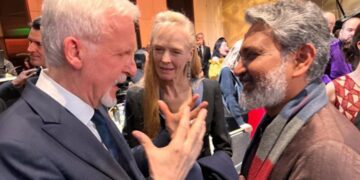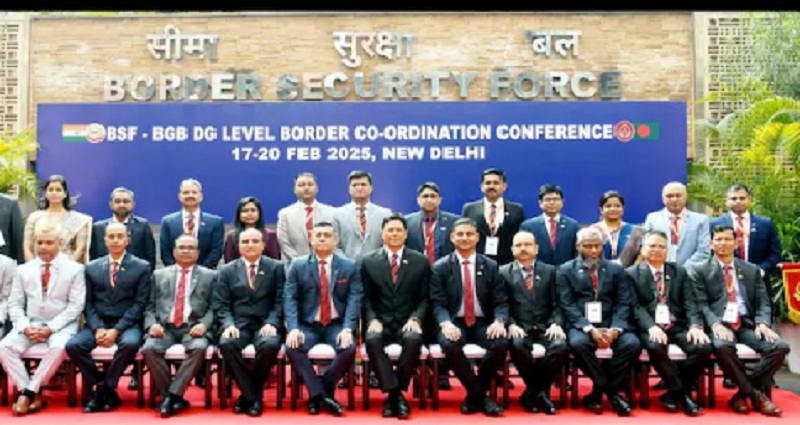The 55th Meeting of Directors General Border Security Force (BSF) and Border Guards of Bangladesh (BGB) ended on February 20 in New Delhi. It was the first meeting of the chiefs of the border forces of India and Bangladesh after the abrupt end of Sheikh Hasina’s government in the neighbouring country.
Though the talks have been business like and candid, the 4,096 km long border with Bangladesh in recent month has been turbulent.
Criminals from across the international border have shown aggression and violence. Several times, large crowd of criminals have attacked small parties of BSF guarding border, thus leaving no option but to act in self-defence.
Even as Bangladesh demands zero killings of its nationals along the international border, every time the BGB has been seen standing as silent spectators, while the criminals openly carried out trans-border adventurism.
The Bangladeshi criminals are active and aggressive along the international border. They attacked several Awami League leaders and other pro-Hasina elements who attempted to cross over to India to evade political persecution.
Earlier, both border guarding forces maintained friendly relations. Unfortunately, since Muhammad Yunus took over as chief advisor, organized crime has seen a sharp rise.
And taking advantage of the fragile law and order system, the notorious ISI and the radical Islamist groups have launched a tirade against the minority communities in Bangladesh, and have scaled up its rhetoric against India.
To everyone’s surprise, Bangladesh has started to place orders for sophisticated battle tanks and also large quantities of automatic weapons.
But, why is Bangladesh trying to strengthen its arsenal? Or, is Bangladesh trying to send any message to New Delhi about its growing military hardware?
The recent visit of senior ISI officials to Dhaka, and a subsequent reconnaissance of the Chicken Neck by a joint team, is a clear indication of Bangladesh’s intentions.
Unfortunately, anti-India rhetoric and strong hate propaganda are gaining ground every day in Bangladesh. Affluent traders and industrialists belonging to minority communities have been attacked; their properties are being looted and destroyed by the criminals.
The minority community in Bangladesh is caught in a state of panic because it is not only their properties and business establishments; even their women are also being attacked.
As the Bangladesh Army has started to hobnob with the ISI, people should not forget that Bangladesh was born in 1971 after the Pakistan Army slaughtered countless students, and Muktijoddha (liberation soldiers).
After the surrender on December 16, 1971, the Pakistan Army had left Bangladesh in a totally war-ravaged state and poor.
The students and Muktijoddhas had played a significant role in the Liberation War of 1971.
It has been seen that the radical Islamist forces always tried to gain ground in Bangladesh. But, the fundamentalist forces remained under tremendous pressure during Sheikh Hasina’s rule in the country.
People did not forget that in 2001 when Khaleda Zia formed a coalition government with Jamat and other Islamist parties, Bangladesh had become the safest haven for all the insurgent groups from Northeast India.
According to reports, her son had masterminded the import of sophisticated weapons from Southeast Asian countries through government channels for the Indian insurgents and even the ISI operatives were helping them.
During the reign of Khaleda Zia, it was seen that Middle-East countries rushed aid to Bangladesh to promote the cause of Islam followers. As a result, radical organisations sprouted and flourished.
While countless Madarsas and Mosques bloomed across Bangladesh during Khaleda Zia’s regime, they received monetary aid from NGOs and Islamic countries.
Bangladeshi women, who always wore sarees, were forced to cover their faces with burqa and hijab.
Apparently, Khaleda Zia even was the brain behind the Institute of Mughalistan, an ambitious corridor connecting Bangladesh, Bihar, UP, Punjab and Rajasthan with Pakistan and Afghanistan.
After Awami League came to power in 2008, the economy of Bangladesh flourished, exports boomed primarily because of special tariffs and concessions granted in Europe and many other countries.
During Sheikh Hasina’s rule, India and Bangladesh harmonised their relations, sorted out water disputes, and the exchange of enclaves and adverse possessions ended the seven-decade-old border dispute.
India has also been kind with Bangladesh – was given healthy aids and concessions in every imaginable field. As a result, the per capita income and GDP graphs sky rocketed.
It is apparent that ‘external forces’ played a pro-active role in toppling the Awami League government in Bangladesh. It is transparent that Sheikh Hasina’s refusal to offer St Martin’s island to the US to set up a naval base resulted in the emergence of Muhammad Yunus.
It is shocking to see that Muhammad Yunus wants to literally nullify all agreements signed by Sheikh Hasina with India.
He is an economist who seems to forget that Bangladesh will find it difficult to survive without good neighbourly and strategic relations with India.
ALSO READ: India-Bangladesh ties in deep-freeze
Despite the anti-India rhetoric and propaganda, Bangladesh should understand that India has neither suspended its aid nor the trade.
If Bangladesh doesn’t understand the reality, it is either heading for massive chaos or an uprising, which Muhammad Yunus will not be able to handle.















